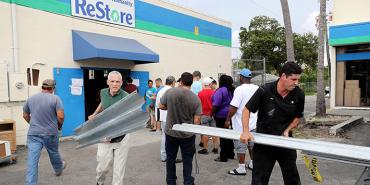
Florida has come a long way since the busy 2004 and 2005 hurricane seasons. With 24 named storms hitting the Sunshine State between the two years, power companies — and Florida — had a lot to learn.
Utility companies and natural energy groups gathered in Fort Lauderdale this week for the Florida Energy Summit to review the progress they’ve made throughout the last 12 years, focusing on power restoration efforts and the work of transportation agencies and gas companies to get Florida back up and running after a natural disaster.
Florida had been relatively free of hurricanes until last year, when Hurricanes Hermine and Matthew made landfall on the state, the first major storms to strike Florida in over a decade.
This year, Florida saw its first Category 4 storm since 2005 — Hurricane Irma — which dumped heavy rains, knocked out power for most of the state and sent many Floridians into unfamiliar territory as they prepared for the monster storm.
Work to prepare for a hurricane like Irma began all the way in 2004, one of the busiest Atlantic hurricane seasons on record.
That year, three storms made landfall in the Central Florida area while many other parts of the state suffered in the dark. Power restoration, lacking adequate technology, was slower and took weeks.
The 2005 hurricane season broke records as the most active hurricane season ever, with a total of 28 tropical and subtropical storms, with 15 becoming hurricanes.
In response, state lawmakers introduced SB888, a bill which required state agencies and utility companies to review power grids and improve the state’s storm resiliency.
The bill also established the nine-member Florida Energy Commission which provides matching grants to stimulate economic development in the solar sector.
Twelve years later, Florida is on the cutting edge of technology to fight back against storms and other natural disasters, with an improved power grid and gadgets like drones which have greatly helped speed up power restoration efforts.
After Hurricane Irma hit, nearly 60 percent of the state was without power, but within a week, nearly all Floridians’ lights had been turned back on.
“We restored power faster than we have ever been able to do in the past,” a Florida Power and Light representative told Sunshine State News.
Gas shortages are also a concern during storms.
At Irma’s peak, nearly 65 percent of Florida’s gas stations were out of fuel in the Miami-Dade area, the most populous part of the state.
"You just have such incredible demand for gas right now as people pack up and leave," said James Miller, director of communications for the Florida Petroleum Marketers and Convenience Store Association.
To help facilitate getting gas to Floridians, Gov. Rick Scott ordered police escorts for gas trucks headed along evacuation routes.
Companies like Speedway have put down ground to provide more gas to Floridians, have ramping up operations over the last decade. Speedway now boasts 2,700 locations in 21 states.
Still, Florida’s recovery from Irma and prep for future hurricane efforts is ongoing.
“We’re going to do everything we can to take care of every person,” Gov. Scott told Fox News’ Shepard Smith last month. “We will not spare one expense.”
Reach reporter Allison Nielsen by email at allison@sunshinestatenews.com or follow her on Twitter: @AllisonNielsen.


